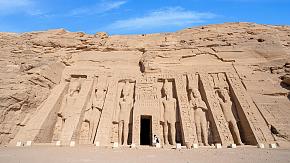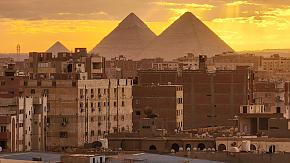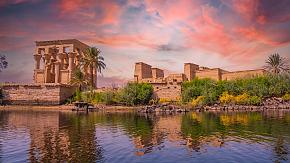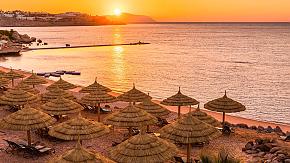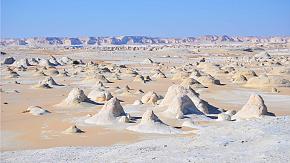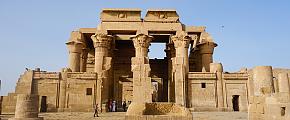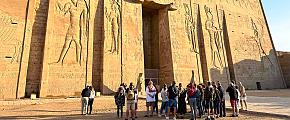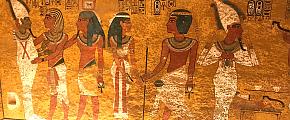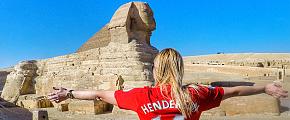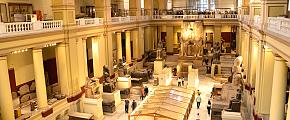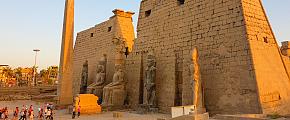Abu Simbel Temples: What to See & When to Go
Abu Simbel Temples is unique for its colossal sculptures and intricately delicate carvings among the hunderds of ancient Egyptian temples. Here we will take you to explore the backstory, highlights, and the best time to visit the Abu Simbel temples, which may help you have a smooth trip.
Basic Information of Abu Simbel Temples
Location: Abu Simbel, a small village in Aswan Governorate in Upper Egypt near the border with Sudan on the western bank of Lake Nasser, about 230 km southwest of Aswan.
Time: from 7 a.m. to 4 p.m. (5 p.m. in the summer)
Entrance ticket: 240 EGP (around 8 dollars or 7 pounds).
A Brief Backstory of Abu Simbel Temples
The temples of Abu Simbel started around 1264 BC and were completed around 1244 BC. The complex, composed of the Great Temple and the Small Temple, was built by Pharaoh Ramesses II and dedicated to a number of ancient Egyptian gods. It was also used to intensify Ramses II's place at the very heart of the people of Nubia and bring them to the king's authority.
After the tenth century BC, the temples gradually fell out of use and were covered by a sand dune. Until the early 19th century, they were rediscovered by European researchers. In the 1960s, the entire site was meticulously divided into huge sections and then put back together in a new location about 60 meters higher so as not to be submerged by the rising waters of the Nile River and Lake Nasser.
Now Abu Simbel is concluded as part of the "Nubian Monuments", a UNESCO World Heritage Site also comprising some Nubian temples such as Philae, Amada, and Wadi es-Sebua.
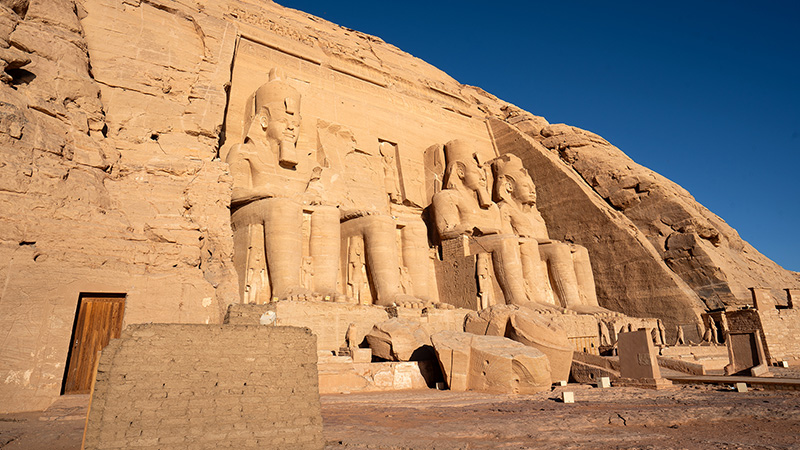
What to See
The Great Temple of Ramesses II
The Great Temple is a considerable part of Abu Simbel Temples and has attracted a large number of visitors since its rediscovery. The temple, carved out of solid rock, is sitting on the west bank of the Nile River and almost opposite Lake Nasser, which enjoys an incredible overlooking view.
The structure is famous for the four majestic colossal statues of the pharaoh Ramses II in front of the temple. All of these huge figures are about 20 meters high and adorned with a double crown, which is a symbol of Upper and Lower Egypt. Looking closely, you will find there are quite small figures, which are thought to be Ramses II's wives and children, on the bottom and around the knees of the colossal statues. Right above the entrance is the figure of the god Ra-Harakhty, to whom the temple was dedicated. Inside the entrance is Hypostyle Hall, on both sides of which stand eight grave and dignified figures of guards.
Another highlight of the Great Temple is that it was built along the axis of the sun. The temple holds a surprisingly periodic illumination on February 22 and October 22 every year. By this time, three of the four seated sculptures-the sculptures of Ra, Amun, and Rameses II-will be illuminated for around 20 minutes by the sunlight, 55 meters into the innermost room of the temple. It is a remarkable sight to behold.
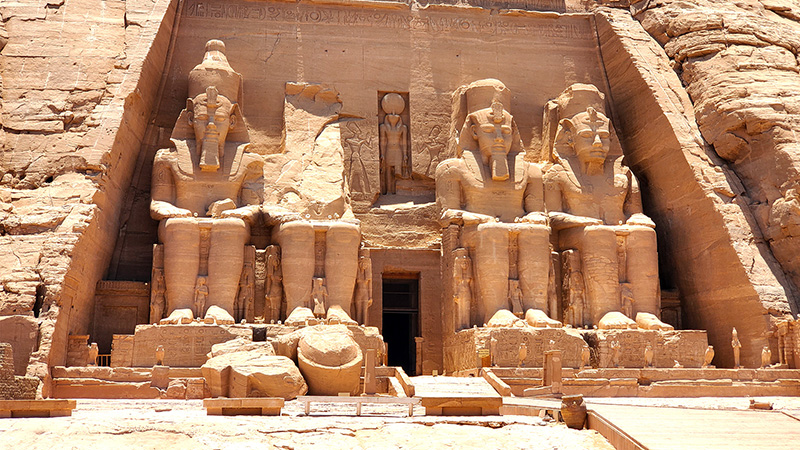 The Great Temple of Abu Simbel
The Great Temple of Abu Simbel
The Small Temple
It is situated next to the Great Temple of Ramses II, just about 100 meters away. The temple was built to commemorate Ramses II's wife, Nefertari, and was dedicated to the god Hathor.
The facade of the Small Temple is flanked by six rocky statues of small size, each 10 meters tall. Four statues are modeled after Ramses II, and two are of his wife, Nefertari. Unlike the statues of the Great Temple, the figures of Queen Nefertari are the same size as Ramesses II himself and are dressed in the goddess Hathor's attire. Around either side of the couple's legs stand some smaller figures of their children.
Inside the temple, one of the most spectacular features is a collection of six pillars that prop up a large hypostyle hall. Each of them is carved into the image of the goddess Hathor on the upper part. On the body of each pillar and the walls are painted mysterious symbols and scenes of Ramses II and Queen Nefertari offering sacrifices to various Egyptian gods.
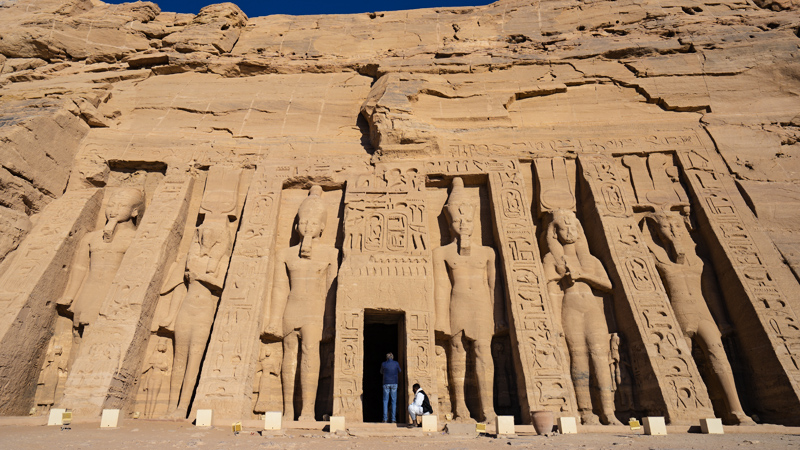 The Small Temple of Abu Simbel
The Small Temple of Abu Simbel
Sound and Light Show
For those spending the night in Abu Simbel, the Sound and Light Show is a fantastic way to enhance your visit. Held daily after sunset, this immersive experience brings the temples to life with dramatic lighting, music, and narration, telling the story of Ramses II and the site's ancient frescoes. The show is available in multiple languages, including English, French, Italian, Spanish, and German. However, if you're returning to Aswan the same day or boarding a Nile cruise, it's best to skip this show due to timing constraints.
The Best Time to Visit Abu Simbel Temples
Abu Simbel has a hot desert climate, with consistently warm temperatures and almost no rainfall, making it a year-round destination.
However, the best time to visit is from December to February, when winter brings pleasantly mild temperatures ranging from 10°C to 23°C. These cooler months are also the busiest tourist season, so expect larger crowds and higher hotel and airfare prices, booking several months in advance is recommended. A highlight of this period is the Abu Simbel Sun Festival on February 22, when the rising sun illuminates the temple's inner sanctuary, drawing thousands of visitors for this breathtaking event.
If you prefer fewer crowds and lower costs, consider visiting between June and August, when temperatures soar to 40°C during the day but drop to a more comfortable 22°C at night. While the extreme daytime heat requires extra precautions, you'll benefit from quieter sites, better photo opportunities, and significant savings on hotels and Nile cruises. If you can tolerate the summer sun, this can be a peaceful and budget-friendly time to experience Abu Simbel.
The best time of day to explore Abu Simbel Temples is early in the morning, right after opening. This allows you to avoid the midday heat and large tour groups that arrive later in the day. The soft morning light also enhances the beauty of the temples, making it ideal for photography.
How to Get to Abu Simbel from Aswan
Abu Simbel is located about 280 km south of Aswan, and it can be reached by many means of transportation.
By Air
The more comfortable and less stressful way to get to Abu Simbel is by air. There are daily flights from Aswan to Abu Simbel operated by Egypt Air. You need to take a 45-minute flight, which comes to around $130–$200 each. The flying journey may be a good buy if you travel alone or with another person. Flying to the temple will save much of your time and offer stunning views of the Nile River and the surrounding desert from the perspective of the sky.
By Bus
Bus services are operated and easily accessible in Aswan. You can take the tour bus or a public bus. For the tour bus, an early catch in the morning between 4 am and 5 am would be helpful. Be mindful that the temple site will be crowded with Aswan tour buses from about 7 am until 11 am. The public bus to Abu Simbel runs once daily from the Aswan bus station and departs at 8:00. The bus journey always takes around four hours.
Driving
If you are inclined to take a road trip, driving from Aswan is a great option to reach Abu Simbel. It will be a special experience at the start of your trip if you don't worry about running short on time. You can hire a private taxi driver through a local or accompanying travel agent or your hotel. The trip by car usually takes about four hours. The cost varies by the number of people in your tour group and will generally be between $500 and $600. While traveling this way allows you to start your journey and visit the site according to your own designated time and offers the opportunity to see some of the rural landscapes of southern Egypt.
Cruising
If you're after a luxurious and relaxing way to get from Aswan to Abu Simbel, taking a cruise along the Nile River and Lake Nasser may be a stunning option. This breathtaking journey will set you back about four or five days. You can book such a cruise through a specialized travel company. You will navigate your way along the Nile on a large cruise ship and Lake Nasser on a small boat. The journey gives a wonderful view of historical temples like Abu Simbel and the many other landscapes along the rivers and lake's banks.
Plan Your Dream Trip to Abu Simbel Temples
Now that you have a better idea of how to visit this awe-inspiring site, why not experience Temples of Abu Simbel for yourself? Let Odynovo craft a personalized itinerary tailored to your interests and travel style. Contact us today and start planning your unforgettable journey to Egypt!
Quick Question
What Our Clients Say
Explore the latest verified reviews of Odynovo's travel services on Tripadvisor, Google, Trustpilot, Product Review and more trusted platforms.

